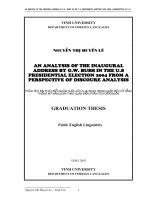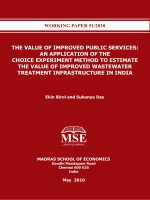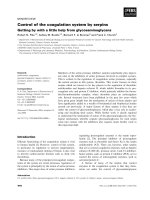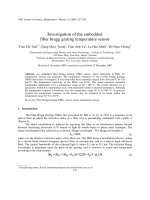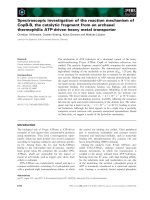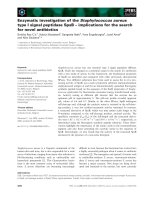Investigation of the wastewater treatment capacity after the mineral exploitation by using africutural wastes sugar cane bagasse peanut shells and coconut fibers
Bạn đang xem bản rút gọn của tài liệu. Xem và tải ngay bản đầy đủ của tài liệu tại đây (2.57 MB, 56 trang )
THAI NGUYEN UNIVERSITY
UNIVERSITY OF AGRCULTURE AND FORESTRY
TRAN THI NHU
INVESTIGATION OF THE WASTEWATER TREATMENT CAPACITY AFTER THE
MINERAL EXPLOITATION BY USING AGRICULTURAL WASTES (SUGAR-CANE
BAGASSE, PEANUT SHELLS AND COCONUT FIBERS)
BACHELOR THESIS
Study Mode: Full-time
Major: Environmental Science and Management
Faculty: International Training and Development Center
Batch: 2012-2016
Thai Nguyen, 15/09/2016
i
DOCUMENTATION PAGE WITH ABSTRACT
Thai Nguyen University of Agriculture and Forestry
Degree Program
Bachelor of Environment Science and Management
Student name
Tran Thi Nhu
Student ID
DTN1253080006
Thesis Title
Investigation of the wastewater treatment capacity after the
mineral exploitation by using agricultural wastes (sugarcane bagasse, peanut shells and coconut fibers)
Supervisor (s)
Assoc.Prof. Dam Xuan Van, Thai Nguyen University of
Agriculture and Forestry
ABSTRACT
This research used agricultural wastes (sugar-cane bagasse, peanut shells and
coconut fibers) as a low cost materials in order to remove the heavy metal in the
wastewater after the mineral exploitation and in laboratory water which was mixed
with a fix concentration of heavy metals (500 mg/l and 1000 mg/l). The results showed
that sugar-cane bagasse, peanut shells and coconut fibers have a very well heavy
metals adsorption capacity. When the amount of adsorption materials increases, the
adsorption capacity of Cu, Pb also increases immediatetly. For example, with sugarcane bagasse, the ability to absorb heavy metals is highest when sugar-cane bagasse
entered is 900g, sugar-cane bagasse can absorb about 71.452% (Treatment 3 Pb F3Pb
with the amount of sugar-cane bagasse is 900g), it increases about 1.66 times
compared with the amount of Pb that it absorbed in treatment 1 Pb ( F1Pb with the
amount of sugar-cane bagasse is 300g). Similarly, the highest amount of peanut sheels
ii
and coconut fibers to absorb the heavy metals is 900g and declining due to reducing
the amount of peanut shells and coconut fibers.
The heavy metals adsorption productivity achieved 30%-80% by comparing with
the initial concentration. It is concluded that agricutural wastes can remove heavy
metals (Pb, Cu)in the wastewater, coconut fibers showed the best heavy metals
absorption capacity followed by sugar-cane bagasse and peanut shells.
Keywords
1. Sugar-cane bagasse
2. Peanut shells
3. Coconut fibers
4. Water pollution
5. Heavy metals
Numbers of Pages
44
Date of Submission
September
, 2016
Supervisor’s signature
iii
ACKNOWLEDGEMENT
From bottom of my heart, I would like to express my deepest appreciation to all
those who provided me the opportunity to complete this research.
First and foremost, I would like to express my deepest gratitude and special thanks
to School Leadership and teachers at International Training and Development Center Thai Nguyen University of Agriculture and Forestry those imparted for me the knowledge
as well as facilitating learning and help me during the learning process in schools. In
particularly, Iwould like to express my sincere gratitude and deep regards tomy
supervisorAssoc.Prof.Dam Xuan Vanin Faculty of Management Resources - who
took time out to hear, guide, support and encourage me on the correct path and
allowing me to carry out my study to have successful results. Especially, hispriceless
advices are not a small contributein orienting my careers and future.
Besides my supervisors, I would like to thank Dr. Tran Thi Pha in Faculty of
Environment, who gave the permission to use all required equipment and the
necessary materials to conduct my reseach in Laboratory of Environment Resources.
Especially, I would like to thanks for her advice, encouragement and guidance during
my thesis.
Moreover, Ialso want toexpress my thanks to the Faculty of Environmentfor
helping and providing me a good laboratory with modern equipment and good
infrastructure that plays an important part in the success of my thesis.
I would also like to thanks to Do Minh Hong, Do Manh Dung, Nguyen Thi Van,
Nguyen Vu Tuan Anh – my classmates, who provided their ongoing support, questions
and suggestions.
iv
Last but not least, I would like to express my love and gratitude to my beloved
parents for their support and endles love.
I would like to sincerely thank!
Thai Nguyen, September
, 2016
Sincerely,
Tran Thi Nhu
v
TABLE OF CONTENTS
List of figures .............................................................................................................. viii
List of tables ...................................................................................................................ix
List of appreviations .......................................................................................................x
PART I. INTRODUCTION ............................................................................................1
1.1.Research rationale .....................................................................................................1
1.2.Research objectives ...................................................................................................3
1.3.Research question and hypotheses ............................................................................3
1.4. Limitations ................................................................................................................4
PART II. LITERATURE REVIEW ................................................................................5
2.1. Overview of heavy metal..........................................................................................5
2.1.1. Definition and sources of heavy metals ................................................................5
2.1.2. Characteristics of heavy metals .............................................................................5
2.2. Overview of Agricultural wastes. .............................................................................6
2.2.1. Sugar-cane bagasse ................................................................................................6
2.2.2. Peanut peels ...........................................................................................................7
2.2.3. Coconut fibers .......................................................................................................8
2.3. The characteristics of heavy metal that related to the study...................................10
2.3.1. Characteristics of Copper (Cu) ............................................................................10
2.3.2. Characteristics of Lead (Pb) ................................................................................11
2.4. Researches on heavy metals adsorption capacity ...................................................13
2.4.1. Research situation in Vietnam .............................................................................13
2.4.2. Research situation in the world ...........................................................................14
vi
and coconut fibers to absorb the heavy metals is 900g and declining due to reducing
the amount of peanut shells and coconut fibers.
The heavy metals adsorption productivity achieved 30%-80% by comparing with
the initial concentration. It is concluded that agricutural wastes can remove heavy
metals (Pb, Cu)in the wastewater, coconut fibers showed the best heavy metals
absorption capacity followed by sugar-cane bagasse and peanut shells.
Keywords
1. Sugar-cane bagasse
2. Peanut shells
3. Coconut fibers
4. Water pollution
5. Heavy metals
Numbers of Pages
44
Date of Submission
September
, 2016
Supervisor’s signature
iii
4.1.3. Assessing the ability to absorb heavy metals (HM) in the wastewater of coconut
fibers 31
4.2.Assessing the Heavy metal adsorption capacity in wastewater by using agricultural
waste in the mining area of Lead, Zinc in Hich Village, Tan Long commune, Thai
Nguyen province............................................................................................................32
4.2.1.Assessing the heavymetal concentration contained in wastewater in the mining
area of Lead and Zinc in Hich Village in Tan Long commune, Dong Hy district, Thai
Nguyen Province ...........................................................................................................33
4.2.2.Assessing the ability to absorb heavy metals (HM) in the wastewater of
agricultural wastes. ........................................................................................................33
PART V. DISCUSSION AND CONCLUSION ............................................................37
5.1. Discussion ...............................................................................................................37
5.2.Conclusion. ..............................................................................................................38
REFERENCES ..............................................................................................................40
viii
LIST OF FIGURES
Figure 3.1. Sugar-cane bagasse .....................................................................................17
Figure 3.2. Peanut shells ................................................................................................18
Figure 3.3. Coconut fibers .............................................................................................18
Figure 3.4. Atomic Adsorption Spectroscopy machine ................................................19
Figure 3.5. Electronic weight scale 4 number Presica XT 120A ..................................19
Figure 4.1. The ability to absorb Heavy Metal of sugar-cane bagasse with the
concentration of Saline solution entered in water is 500 mg/l ......................................28
Figure 4.2. The ability to absorb Heavy Metal ofsugar-cane bagasse with the
concentration of Saline solution entered in water is 1000 mg/l ....................................28
Figure 4.3. The ability to absorb Heavy Metal of peanut peels with the concentration
of Saline solution entered in water is 500 mg/l .............................................................30
Figure 4.4. The ability to absorb Heavy Metal of peanut peels with the concentration
of Saline solution entered in water is 1000 mg/l ...........................................................30
Figure 4.5. The ability to absorb Heavy Metal of coconut fibers with the concentration
of Saline solution entered in water is 500 mg/l .............................................................32
Figure 4.6. The ability to absorb Heavy Metal of coconut fibers with the concentration
of Saline solution entered in water is 1000 mg/l ...........................................................32
Figure 4.7. The ability to absorb HM of sugar-cane bagasse with different contents ..35
Figure 4.8. The ability to absorb HM of peanut shells with different contents ............36
Figure 4.9. The ability to absorb HM of coconut fibers with different contents ..........36
ix
LIST OF TABLES
Table 3.1: The time for taking the water samples .........................................................20
Table 4.1: The ability for adsorbing the HM of sugar-cane bagasse ............................27
Table 4.2: The ability for adsorbing the HM of peanut shells ......................................28
Table 4.3: The ability for adsorbing the HM of Coconut fibers....................................31
Table 4.4. The concentration (mg/l) of heavy metal in wastewater after the mineral
exploitation in the mining area of Lead, Zinc in Hich Village......................................33
Table 4.5. The ability to absorb HM Pb in wastewater after the mineral exploitation of
sugar-cane bagasse, peanut shells and coconut fibers. ..................................................34
x
LIST OF ABBREVIATIONS
ABBREVIATIONS
MEANING
AAS
Atomic adsorption spectroscopy
AP
Adsorption Productivity
HM
Heavy metal
MONRE
Ministry of Natural Resources and Environment
ISO
International Organization for Standard
WHO
World Health Organization
xi
PART I. INTRODUCTION
1.1. Research rationale
Nowadays, Environmental pollution is one of the biggest problems that the
world arefacing. It has brought an enormous affect to human’s life and other
organisms. Within the general context of world pollution, water environment in
Vietnam
is also severely degraded; especially water environment is becoming
increasingly serious. Most of the earth’s surface is covered by water; most of
human’sbody arecomposed of water. These are two facts illustrating the critical
linkages between water, health and ecosystems. It can be seen that, water is the most
essential compound on the earth for human activities. Providing clean water is the
prime requirement of the human being for their better health. Since the fast growing
sector of industries, expansion of population, and urbanization have a large contributed
to the severe contamination of water. Chemicals and fertilizers use in domestic and
agricultural activities leads to the lifetime threatening diseases. Intense use of heavy
metals in industries for dyeing, paint, etc is becoming one of the most serious
environmental problems globally. Its presence in low concentration of heavy metals in
various water resources could be harmful to human health and all the organisms in the
aquatic environment. The treatment of heavy metals is very important due to their
persistence in the environment. Therefore, the study and finding the methods to treat
the heavy metal in water environment and contributing to environmental improvement
is urgently needed. Besides the raising awareness of human, tightening environmental
management, finding methods to remove heavy metal ions, organic compounds toxic
1
ACKNOWLEDGEMENT
From bottom of my heart, I would like to express my deepest appreciation to all
those who provided me the opportunity to complete this research.
First and foremost, I would like to express my deepest gratitude and special thanks
to School Leadership and teachers at International Training and Development Center Thai Nguyen University of Agriculture and Forestry those imparted for me the knowledge
as well as facilitating learning and help me during the learning process in schools. In
particularly, Iwould like to express my sincere gratitude and deep regards tomy
supervisorAssoc.Prof.Dam Xuan Vanin Faculty of Management Resources - who
took time out to hear, guide, support and encourage me on the correct path and
allowing me to carry out my study to have successful results. Especially, hispriceless
advices are not a small contributein orienting my careers and future.
Besides my supervisors, I would like to thank Dr. Tran Thi Pha in Faculty of
Environment, who gave the permission to use all required equipment and the
necessary materials to conduct my reseach in Laboratory of Environment Resources.
Especially, I would like to thanks for her advice, encouragement and guidance during
my thesis.
Moreover, Ialso want toexpress my thanks to the Faculty of Environmentfor
helping and providing me a good laboratory with modern equipment and good
infrastructure that plays an important part in the success of my thesis.
I would also like to thanks to Do Minh Hong, Do Manh Dung, Nguyen Thi Van,
Nguyen Vu Tuan Anh – my classmates, who provided their ongoing support, questions
and suggestions.
iv
this method is going from inexpensive raw materials, availability, simple process, the
cost of handling is low, simultaneous separation many type of metal in the solution,
and recovery of metals and no added the toxic agents to environment. Specifically,
sugar-cane bagasse, coconut fibers, peanut shells are popular materials in Vietnam
with annual output of very large. Stemming from the above reality and expectations of
myself, under the advisor of Assoc.Prof.Dam Xuan Van, I conducted my thesis:
“Investigation of the wastewater treatment capacity after the mineral exploitation by
using the agricultural wastes (sugar-cane bagasse, peanut shells and coconut
fibers)”.
1.2. Research’s objectives
The primary objective of this study is removing the heavy metal in wastewater
by using the agricultural by-products. In order to meet the main objective of the study,
the following specific objectives are adopted:
(a) Finding a safe method and low cost adsorbents for various agro and
horticultural waste by-products which could adsorb heavy metal in wastewater.
(b) Investigation of the factor affecting to the absorption of heavy metal in
water of agricultural products and by-products such as: time, metal concentration.
(c) Giving the application for the use of wastewater after conducting
experiments.
1.3. Research question and hypotheses
With many advantages in the environmental fields, the application of
agricultural wastes in wastewater treatment capacity is a good effective measure to
3
remove the heavy metals. And this scientific research will seek to answer the central
research questions:
(a) Which kind of agricultural wastes have the best ability to adsorb the heavy
metal in the wastewater?
(b) How to investigate the heavy metal adsorption capacity of agricultural
wastes?
(c) Which kinds of heavy metal that agriculturalwastes can adsorb?
1.4. Limitations
Because the thesis training time was too short, this research project cannot
perform many other experiments and estimate deeply about the factor affecting to the
absorption of heavy metal in wastewater by using Agricultural wastessuch as: pH, time
and metal concentration.
4
PART II.LITERATURE REVIEW
2.1.Overview of heavy metals
2.1.1. Definition and sources of heavy metals
The original of the term “heavy metals” is not clear. An early use dates from
1817, when Gmelin divided the elements into nonmetals, light metals and heavy
metals (Habashi,2009). Light metals had densities of 0.860 – 5.0 gm/cm3; the density
of heavy metals is 5.308 – 22.000gm/cm3 (Gmelin, 1849). Heavy metals are divided
into three types: toxic metals (Hg, Cr, Pb, Zn, Cu, Ni, Cd, As, Co, Sn, etc), precious
metals (Pd, Pt, Au, Ag, Ru, etc.), and radioactive metals (U, Th, Ra, Am, etc.). The
proportion of these metals is usually greater than 5 g/cm3(Bishop, 2002).
Heavy metals are found naturally in the earth, which become concentrated as a
result of human caused activities. Common sources are from mining and industrial
wastes; vehicle emissions; lead-acid batteries; fertilizers, paints and treated woods.
Lead is the most prevalent heavy metals contaminant.
2.1.2. Characteristics of heavy metals
Heavy metals are not biodegradable (Tam & Wong, 1996) and no toxic in the
form of elements, but they are very dangerous to living organisms when they are in the
form of cations due to its linkage capacity with short carbon chain, which leads to the
accumulation in the organism after several years. For humans, appropriately 12
elements of heavy metals cause toxic such as lead, copper, nickel, etc. Some heavy
metals are found in the body and essential for human health, such as iron, zinc,
magnesium, cobalt, copper, although the amount is very small but it presents in
metabolism. However, at excess level of the essential elements it can endanger the life
5
of the organism (Foulkes, 2000). The remaining metal elements are unnecessary
elements and can be highly toxic when it occur t in the body; however, the toxic only
present when they enter the food chain. These elements include mercury, nickel, lead,
copper, etcin the form of metal ion. They enter body through the streets of body to
absorb as respiratory, gastrointestinal and through the skin. If heavy metals enter the
body and accumulate inside the cell is greater than the resolution of them, they will
increase and the poisoning will appear (Foulkes, 2000). The toxicity of heavy metals is
expressed through:
(1) Several heavy metasl can be moved from lower to higher toxicity in the
form of some environmental conditions, such as mercury.
(2) Toxicity of these elements may be at a very low concentration of about 0.110 mg.L-1 (Alkorta et al.,2004).
2.2. Overview of Agricultural wastes.
2.2.1. Sugar-cane bagasse
Sugar-cane bagasse is one of the inexpensive and widely available agro-industrial
wastes produced in Vietnam. Indeed, sugar-cane industry produced an enormous
amount of sugar-cane bagasse. According to the estimation of scientists, processing 10
million tons of sugarcane to make sugar has spawned a huge amount of waste: 2.5
million tons of sugar-cane bagasse.In the past, 80% of sugarcane bagasse is used for
the boiler in the sugar factory and it produced 50,000 tons of ash.Although it is wastes,
there are many organic acrid in the ash and mud. These compounds will cause
environmental pollution and especially water pollution. Sugar-cane bagasse accounted
for 26.8 – 32% the amount of sugar-cane. Inside sugar-cane bagasse contained about
6
Last but not least, I would like to express my love and gratitude to my beloved
parents for their support and endles love.
I would like to sincerely thank!
Thai Nguyen, September
, 2016
Sincerely,
Tran Thi Nhu
v
are the components that contain cellulose, hemicellulose, pectin, lignin, and protein,
making them a good candidate for use in wastewater treatment (Kumar, 2006). The
structures of these compounds have functional groups that invite metal ion exchange
and metal chelation.
Chemical modification of the hulls will help determine the type of binding
involved in the adsorption process. Differences in adsorption among different
treatments may indicate the chemical nature of the binding interaction. The
pretreatment to be performed in this study is the alkaline oxidation/delignification of
the hulls. The biopolymers contain a variety of functional groups, such as alcohol
groups, which can be chemically altered to possibly enhance the adsorption of metal
ions. Oxidation of the hulls involves oxidizing the alcohol groups of the cellulose into
carboxylate groups, which would create a cationic exchanger for the metal ions,
increasing adsorption. The newly formed carboxylate groups exchange cations,
meaning the countering (Na in this case) leaves the carboxylate group and the metal
ion in solution attaches in its place as shown in the reaction scheme below (Shukla et
al., 2005; Öztürk, 2009; Nevell, 1985).
2 RCOONa + Cu2+—> (RCOO)2Cu + 2 Na+
This modification has been tested in previous studies on adsorbents composed
of mainly cellulose and lignin, such as jute fibers, resulting in enhanced effectiveness
of metal ion adsorption.
2.2.3. Coconut fibers
The coconut can be found across much of the tropical and subtropical area, it is
known for its great versatility as seen in any domestic, commercial and industrial uses
8
of its different parts. Coconut is part of the daily diet of many people. It is known as
the edible flesh of the coconut; when dried it is called the copra. The oil and milk
derived from it are commonly used in cooking and frying; coconut oil is also widely
used in soaps and cosmetics. The clear liquid coconut water within is a refreshing
drink and can be processed to create alcohol. The husks and leaves can be used as
material to make a variety of products for furnishing and decorating, while the coconut
fiber dust have been used as raw material for activated carbon industries.
Coconut fibers waste is one of the agricultural waste products often used as
adsorbent in waste water treatment. It’s all year round availability and its abundance in
the environment makes it a good source of adsorbent for metal ion removal from
aqueous solution. It is the light, fluffy material that falls off from the thick monocarp
of coconut fruit when shredded during fiber processing. The remarkable properties of
fiber dust that enhances its effectiveness as adsorptive/ion exchange capacities include
good structural stability, high water absorptivity and high porous nature (Reginald,
1974). Its constituents include ligmin-36.15%, cellulose-33.61%, pentosana-29.27%,
ash-0.61%, dry basis (Woodroof, 1979).
The other constituents are kemicelluloses and extractives. These extractives
contain tannins, pectins, with polyhenolic, carboxyl and hydroxyl groups. Ligmins and
cellulose in the fiber affords its adsorptive/ion exchange properties. The porous
structure of the fiber dust allows it to absorb large amount of water but still, remain
insoluble very much like any synthetic hydrogel (Armstrong, 2008).
9
2.3.The characteristics of heavy metal that related to the study
2.3.1. Characteristics of Copper (Cu)
Copper is a widely used material. It can be found as contaminant in food. This
form of contamination emanates from the use of copper material in the packaging of
food. Despite the essential nature of copper to human life and health, it is potential
toxic. For instance, continuous inhalation of copper-containing spray is linked with an
increase in lung cancer among exposed workers. Copper is released into the
environment in a number of different ways, it find its way into water streams resulting
in environmental contamination that poses threat to humans, animals and plants. This
can cause serious and complex problem (Papandreous et al.,2007; Pentari et al.,2009).
Like other heavy metals, copper in trace amount is necessary for life processes.
However, with higher concentrations of this element in the environment and the
consequent increase in human intake, copper concentration have reached toxic levels
causing various diseases and disorders such as liver damage, Wilson disease and
insomnia (Kurniawan et al.,2006).
Importance of Copper (Cu)
Effect on human
Copper is a trace element which is essential to living organisms. It is essential
for the proper functioning of organs and metabolic processes in humans. Ingestion of
high concentrations of copper salts is associated with symptoms relating to abdominal
pain, headache, nausea, dizziness, vomiting and diarrhea, tachycardia, liver and kidney
failure and death. These symptoms subside when copper in the drinking water source
is reduced. Chronic copper poisoning leading to liver failure was reported in a young
10
adult male with no known genetic susceptibility who consumed 30 – 60 mg/l of copper
as a mineral supplement for 3 years (O’Donohue et al.,1999)
In addition, copper is considered to be one of the elements necessary for human
but the accumulation of copper with high concentration can be toxic to the body.
Cumings (1948) quoted in WHO (1998) discovered copper is actually toxic agents for
Wilson patients and discover that the liver and brain of these patients contained metal
content is very high.
Effect on Aquatic Life
Excess Cu(II) in water may damage marine and freshwater organisms such as
fish and mollusks (Van et al., 2005). Fish species vary in their sensitivity to copper,
with the LD50 for 96-h exposure to copper sulphate reported to be in the order of 58
mg per liter for Tilapia (Oreochromis niloticus) and 70 mg per liter for catfish (Clarias
gerieppinus)
(Ezeonyejiaku
et al.,2011).
The
chronic
effect of
sub-lethal
concentrations of Cu(II) on fish and other creatures is demage to gills, liver, kidneys
and the nervous system. It also interests with the sense of smell in fish, thus preventing
them from choosing good mates or finding their way to mating areas (Flemming et al., 1989).
2.3.2. Characteristics of Lead (Pb)
Lead is a bluish-white lustrous metal. It is very soft, highly malleable, ductile,
and a relatively poor conductor of electricity. Lead compounds are widely used in fuel
industry, the manufacture of glass, ceramics, painting, medicine.Lead is a typical
element for toxicity. All compounds that dissolve with this element are poisonous.
11
Source by human activity:
Lead is used in batteries, the battery, in some instruments conductivity. Some
lead compounds are added in paint, glass, ceramics, such as colorants, stabilizers,
binder.
The waste products from the application of lead if not recycled properly, when
released into the environment will increase the amount of this toxic metal. Also some
organic lead compounds such as lead tetrametyl or tetraetyl added in gasoline,
especially in developing countries.
Importance of lead (Pb)
Effect on human
In human body, Pb in the blood associated with erythrocytes and accumulates
in the bone. The ability to remove lead from the body is very slowly, primarily in the
urine. Half-life of lead in the blood is about a month, in bones of 20-30 years. The
organic lead compounds are sustainable, harmful to humans, can lead to death.
The expression of acute lead poisoning, such as headache, irritability,
excitability, and many differences expressions related to the nervous system. Humans
infected long term may lead to memory loss, decreased ability to understand, reduce
IQ, scrambling ability to synthesize hemoglobin can lead to anemia. Lead is known to
be the cause of lung cancer, stomach and gliomas. Lead poisoning can cause harmful
effects on reproductive capacity, miscarriage.
Effect on Aquatic Life
Lead can enter water systems through runoff and from sewage and industrial
waste streams. Elevated levels of lead in the water can cause reproductive damage in
12
TABLE OF CONTENTS
List of figures .............................................................................................................. viii
List of tables ...................................................................................................................ix
List of appreviations .......................................................................................................x
PART I. INTRODUCTION ............................................................................................1
1.1.Research rationale .....................................................................................................1
1.2.Research objectives ...................................................................................................3
1.3.Research question and hypotheses ............................................................................3
1.4. Limitations ................................................................................................................4
PART II. LITERATURE REVIEW ................................................................................5
2.1. Overview of heavy metal..........................................................................................5
2.1.1. Definition and sources of heavy metals ................................................................5
2.1.2. Characteristics of heavy metals .............................................................................5
2.2. Overview of Agricultural wastes. .............................................................................6
2.2.1. Sugar-cane bagasse ................................................................................................6
2.2.2. Peanut peels ...........................................................................................................7
2.2.3. Coconut fibers .......................................................................................................8
2.3. The characteristics of heavy metal that related to the study...................................10
2.3.1. Characteristics of Copper (Cu) ............................................................................10
2.3.2. Characteristics of Lead (Pb) ................................................................................11
2.4. Researches on heavy metals adsorption capacity ...................................................13
2.4.1. Research situation in Vietnam .............................................................................13
2.4.2. Research situation in the world ...........................................................................14
vi
spite of the very high levels. Although, the concentrations of these compounds in
Vetiver do not high as in some other plants varieties accumulation, it grows very fast
and have a high productivity (productivity of dry grass up to 100 tons/ ha /year),
Vetiver grass can reduce amounts of nutrients and heavy metals is much greater than
most other varieties plants accumulation. Fern trees - a tree that grows of wild in
Vietnam also has the ability to handle heavy metals in the water. Adsorption
performance of Pb (II), Cu (II), Cd (II), Zn (II), Ni (II) by ferns is quite high, reaching
99.5% for Pb (II), 84.5% for Cu (II), 87.5% for Cd (II), 73.2% for Zn (II) and 64.6%
for Ni (II) in the balance pH and initial concentration of 50 mg / l.
Although,nowadays the research and application of natural materials,
agricultural waste and industrial waste in order to handle heavy metals in the water in
Vietnam is attracting many scientists. However, this is the basic research that aims to
explore the possibility of handling the heavy metal with environmental friendly
materials. On the other hand, the potential application of natural materials and
agricultural and industrial waste in wastewater treatment that polluted with the heavy
metal pollution in Vietnam is huge. Therefore, the study of the applicability of
agricultural by-products such as: sugar-cane bagasse, coconut fibers, peanut shells to
handle heavy metals in wastewater are essential and it have a highly significant for
science and practical.
2.4.2. Research situation in the world
Currently, the process of mining exploitation is increasingly polluting and has a
heavily degradedto aquatic environment and it is an alarming fact. The types of
environmental pollution at the mining area has been exploited, are very diverse such as
14
